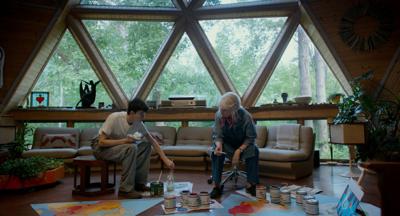
Asa Butterfield and Ellen Burstyn star in “House of Tomorrow,” Peter Livolsi’s 2017 independent film about a young man who goes on a road trip in search of meaning in his life. The film delves into the life and story of Buckminster Fuller, who was affiliated with the Aspen International Design Conference in the early 1950s and built one of the first geodesic domes there on the Aspen Institute campus in 1952. The film is screening as part of Aspen Film’s Science on Screen series.
The 2017 film “House of Tomorrow” plays Wednesday at 6:30 p.m. at the Isis Theatre. It is the fourth and final installment of Aspen Film’s Science on Screen Series. It is presented in association with the Aspen Science Center. The movie is preceded by the short film “Chilly & Milly,” directed by William D. Caballero.
At each screening of the series, classic and cult films are paired with short films and expert guest speakers who discuss the cultural, scientific, technological or medical issues raised by each film, allowing audiences to experience the intersection of film and science through a cinematic lens.
Science on Screen is in its second season. It also connects audiences with organizations in the valley who share an interest in providing cross-sectional engagement and learning between the arts and science. It is a nationwide initiative of the Coolidge Corner Theatre with support from Alfred P. Sloan Foundation. Additional in-school enrichment is available for local students and teachers.
“This series allows us to demonstrate the mission of enlightening, enriching, educating and entertaining through film,” Susan Wrubel, executive and artistic director of Aspen Film, said.
“House of Tomorrow” is a 2017 independent coming-of-age film about a young man who goes on a road trip in search of meaning in his life. The film stars Asa Butterfield, Alex Wolff and Ellen Burstyn.
In the movie, Sebastian (Butterfield) lives with his grandmother Josephine (Burstyn) but longs to leave his lonely existence. That changes when he meets Jared, a young punk rocker with a heart condition and his sister Meredith. Sebastian decides to pick up a guitar and join Jared in becoming a punk group.
The special guest at Wednesday’s screening is longtime Roaring Fork Valley journalist Andrew Travers, who is now the manager of educational programs at the Resnick Center for Herbert Bayer Studies.
In “House of Tomorrow,” the Sebastian character lives in a geodesic dome — a rounded hemispherical structure made of flat, thin-shell polygons (think a common greenhouse shape) — with his grandmother. The geodesic dome was pioneered by Buckminster Fuller, who spent time at the Aspen Institute in the early 1950s and built one of the first geodesic domes there 1952.
“The thread we’re looking at with ‘House of Tomorrow’ is the work of Buckminster Fuller, the influential designer, futurist and inventor,” Travers said. “He worked with the Aspen International Design Conference in its early years. He built one of the first geodesic domes on the Aspen Institute’s campus which is still here. It’s an incredible piece of design history.”
The inaugural International Design Conference in Aspen occurred in 1951 and ran until 2006. It served as a forum to discuss developments in design, the arts, sciences and humanities. It evolved into the Aspen Ideas Festival.
Just a year after completing the dome in Aspen, the Ford Motor Company hired Fuller to create a dome that would enclose a central courtyard at the company’s headquarters. Within months, Fuller finished the project ahead of schedule, covering the opening above the courtyard as planned. It was deemed an architectural feat.
Fuller provides a direct link to Herbert Bayer who studied and taught at the Bauhaus before emigrating from Germany to the United States in 1938. Between 1946 and 1975, Bayer was instrumental in Aspen’s postwar revitalization that embodied mind, body and spirit. Bayer designed the Aspen Institute campus, and shaped the organization’s early artistic vision. His legacy is now preserved by the Resnick Center for Herbert Bayer Studies.
Both Bayer and Fuller were visionaries in multiple disciplines from the visual arts to architecture. Fuller wrote 30 books about myriad topics. He was a serial inventor, holding 28 patents, which were mostly architectural designs. While he did not invent the geodesic dome, he pioneered the use of it in the United States.
Geodesic domes were strongly associated with the counterculture movement, particularly in the 1960s and ’70s. They were particularly well-suited for communities that sought to be self-sufficient and those in rural areas as they could be constructed with relatively few materials and minimal expertise. They therefore resonated with the counter culture’s emphasis on self-sufficiency, sustainability and communal living.
Sebastian’s grandmother is a disciple of Fuller’s philosophy, both living in a geodesic dome and embodying and advocating for his minimalist lifestyle and philosophy.
Asked what she hopes audiences take away from attending a “Science on Screen” program, Alex Tarika, education manager of the Aspen Science Center, said, “What ‘Science on Screen’ does is it tries to connect and engage audiences in how films use technology, stem science, technology, engineering and mathematics in various ways.
“I think the most important takeaway is the fact that film isn’t just entertainment, that it can be educational and make something more relevant to someone rather than just hearing scientific data.”


